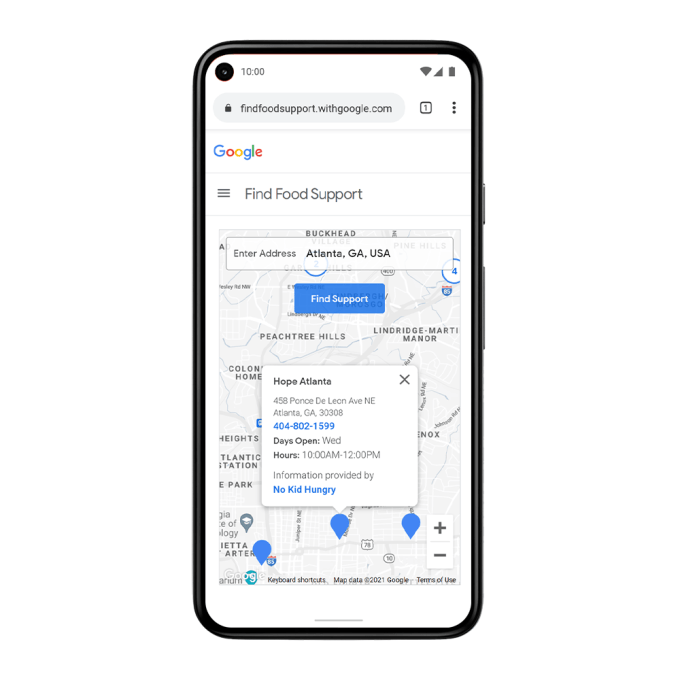Google today is launching a new suite of resources for people struggling with food insecurity across the U.S. The project includes the launch of a new website, “Find Food Support,” that connects people to food support resources, including hotlines, SNAP information, and a Google Maps locator tool that points people to their local food banks, food pantries and school meal program pickup locations, among other things.
In an announcement, Google explains how the Covid-19 pandemic fueled a worsening food crisis in the U.S., which led to some 45 million people — or 1 in 7 Americans — experiencing food insecurity at some point during 2020. That figure was up 30% over 2019, the company noted. And of those 45 million people, 15 million were children.
While the pandemic’s impacts are starting subside as businesses are reopening and in-person activities are resuming, many children will still go hungry during the summer months when school lunch programs become unavailable.
To help address this need and others related to food insecurity, Google’s new website available at g.co/findfoodsupport offers a combination of food support resources, YouTube videos about the problem of food insecurity in the U.S., and a Google Maps locator tool that will direct people to their nearby food bank or other food support locations.
Google says it worked with organizations including No Kid Hungry, FoodFinder, and the U.S. Department of Agriculture to capture 90,000 places offering free food support across the 50 U.S. states. Using the online tool, website visitors can type in their location to see school meal program pickup sites, food banks and food pantries in their area.

Image Credits: Google
The tool will display the location’s address, phone number and other details — like which days it’s open or business hours.
Although you can find this information in Google Maps directly, it can be more difficult if you don’t know the right keywords to use. For example, a search “food support” returned a combination of charities, food banks and public services alongside businesses with matching keywords, like “Food Lion” and “Lowe’s Foods.” A search for “food assistance” was more complete, but also returned unrelated results, like the “US Food & Drug Administration.” The online tool’s search results will be more precise and accurate.
The new website also highlights other food support information, including SNAP benefit information; support for specific groups, like seniors, children, and families; state-by-state benefit guidelines; and food support hotlines. For those not facing food support issues, it offers information on how to donate money, time or food to those in need.
The site additionally features a handful of YouTube videos published by organizations across the country who are working to address food insecurity issues in their own communities. The videos aim to destigmatize food insecurity by showing how all types of people use food support — including military families, children, and seniors. Google says 1 in 9 active-duty military families experience food insecurity, as do 1 in 6 children, 1 in 3 college students, and over 5 million seniors, for example.
The new site is the result of an effort by Google’s “Food for Good,” headed by Emily Ma. Food for Good originally began as an early stage moonshot project (from Alphabet’s X, formerly Google[x]) known as Project Delta, which focused on creating a smarter food system. The team wanted to find ways to keep food waste out of landfills by better directing food to those who need it most. In December 2020, Ma announced Project Delta would be moving to Google to scale up its work. The core team then joined Google as “Food for Good,” while the food traceability team remained at X to work on broader issues.
Google says it will continue to add more food support locations to the food locator tool going forward, beyond the 90,000 it offers today.
Comments
Post a Comment